SPRING SEEDING: WHEN?
Truth From a Thermometer
Stop by my vegetable garden this time of year and you might see one or more thermometers poking out of the ground. No, I’m not experimenting with a new way to monitor the soil’s health. Soil temperature can serve as a guide for timely sowing of seeds outdoors. Seed sown in soil that is too cold won’t germinate; just sitting there waiting for warmer weather, ungerminated seeds are liable to rot or be eaten by animals.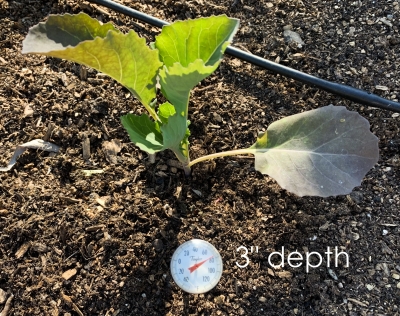
Lettuce, onion, parsnip, and spinach seeds can be planted earliest. They’ll germinate just about as soon as ice in the soil thaws. At the other end of the spectrum are seeds of melons and squash, which won’t germinate until the soil temperature reaches sixty-five degrees. The minimum temperature required for germination of other vegetable seeds is as follows: forty degrees for beets, cabbage and its kin, carrots, peas, chard, parsley, celery, and radishes; fifty degrees for sweet corn and turnips; and sixty degrees for beans, cucumbers, and okra.
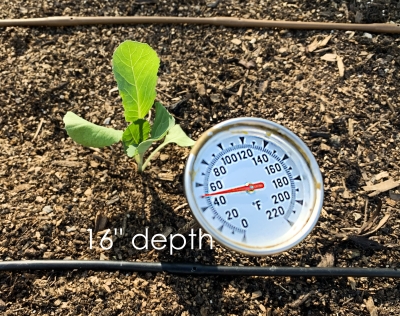 The above listing gives minimum, not optimum, temperatures for germination. Optimum temperatures might be even thirty degrees higher than the minimums, as in the case of celery which germinates quickest at seventy degrees. Waiting for the optimum temperature isn’t advisable, though. To delay sowing until the soil temperature reached the optimum temperature for pea germination (seventy-five degrees) would result in a midsummer harvest, when hot, dry weather turns peas coarse in taste and texture.
The above listing gives minimum, not optimum, temperatures for germination. Optimum temperatures might be even thirty degrees higher than the minimums, as in the case of celery which germinates quickest at seventy degrees. Waiting for the optimum temperature isn’t advisable, though. To delay sowing until the soil temperature reached the optimum temperature for pea germination (seventy-five degrees) would result in a midsummer harvest, when hot, dry weather turns peas coarse in taste and texture.
But What Temperature is Best?
For indoor seeding in seed flats, I use an electric, thermostatically controlled heating mat, waterproof and made for seed germination. With so many different kinds of seeds to grow, I can’t be twisting the thermostat dial up and down to suit each seed’s optimum. The temperature remains set at about 80 degrees. Which is why lettuce sown a couple of weeks ago still hasn’t sprouted.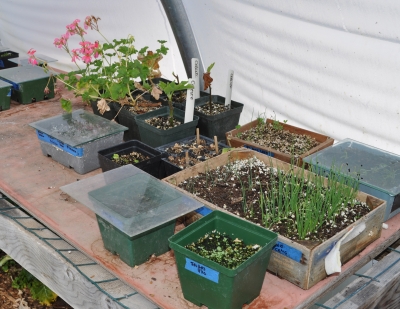
Each kind of seed also has a maximum temperature at which it will sprout. For lettuce, that’s about 80 degrees. I resowed a few days ago, setting the lettuce flat on the cooler greenhouse bench instead of the mat, and green leaves have already shown their faces. Other vegetable seeds notorious for sulking in the heat are parsnip, celery, and pea. Turnip is interesting for being eager to sprout anywhere in the broad range of 60 to 105 degrees!
For more details on temperatures needed for seed germination, as well as plant growing and charts and tables with lots of other stuff about growing vegetables, I highly recommend Knott’s Handbook for Vegetable Growers, available in hard copy or online.
Tips to Advance the Season
No need to twiddle your thumbs waiting for the soil to warm; the warming process can be speeded up. (I detail a number of ways to do this in my book Weedless Gardening.) A thick, organic mulch, though generally beneficial to the soil, insulates the soil and hence delays warming this time of year. So for early sowings, rake back the mulch to expose the soil to the sun. Once the soil is warm — about mid-June — replace the mulch to recoup its benefits.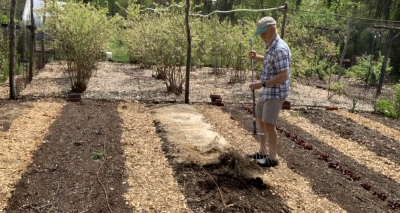
Where soil is not blanketed with mulch, warming can be hastened by forming small ridges oriented east and west. You plant seeds on the south faces of these ridges. With sunlight beaming directly down on these south-facing ridges, the soil there warms a bit faster than the surrounding soil. 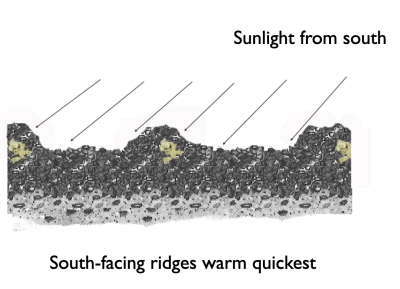 (For the same reason, here in the Northern Hemisphere, south-facing slopes are warmer than north-facing slopes. North-facing slopes ideal for planting peaches and apricots to delay their flowers to when there’s less possibility of a later spring frost snuffing them out.)
(For the same reason, here in the Northern Hemisphere, south-facing slopes are warmer than north-facing slopes. North-facing slopes ideal for planting peaches and apricots to delay their flowers to when there’s less possibility of a later spring frost snuffing them out.)
Another way to warm the ground for early spring planting is to grow plants in raised beds. In raised beds the soil warms early because it’s more exposed to ambient air temperatures. Raised beds are well-drained, so dry more quickly; it takes more heat to warm a wet soil than a dry soil.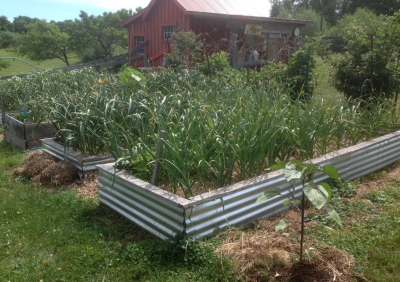
Changing the color of the soil surface affects its temperature. Black plastic mulch is unsightly, but it does warm the soil. Hide the plastic’s ugliness with a layer of bark chips and the plastic’s warming effect will be lost. In climates such as ours, where the soil is just marginally warm enough for vegetables like peppers, melons, and eggplants even in summer, the plastic mulch improves growth if left in place the whole season.
A top layer of compost on the ground darkens the soil in a more attractive manner than black plastic, though the effect on soil temperature is less dramatic. Compost does, of course, confer other benefits to the soil, such as improving the soil’s physical structure and providing essential nutrients. These benefits are lacking with black plastic.
Natural Indicators
All these techniques warm the soil a little faster than it would otherwise. You can measure the effect with a soil thermometer, but a thermometer is not mandatory for determining when to sow seeds. The soil slowly but surely warms up at about the same rate each spring, so you can sow by calendar dates, subtracting a few days if you deliberately hasten soil-warming. 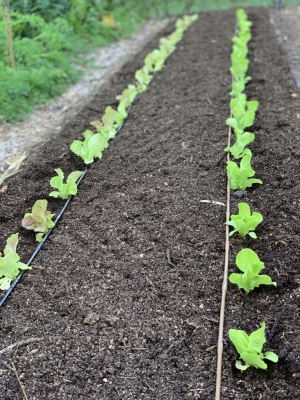
Since the soil temperature and spring blossoms are influenced by the same general warming trend, even better is to sow seeds according to what perennial or woody plants are in bloom. For instance, you might plant peas just as the forsythias blossom, and corn according to the traditional indicator — when oak leaves are the size of mouse ears. A soil thermometer should register about forty degrees in the first case, and fifty degrees in the second.


Very interesting post. Why do you measure temperature at 3″ and 16″ and assume it’s the 3″ that is the number to use for determining when to plant seeds. Also, regarding your “Gourmet Compost” post, do you feed the Brussels sprouts only at planting time with the high nitrogen fertilizer?
Seeds are planted at at depth of 3″ or less; that’s the area for seed germination. Eventually, some roots will descend lower. But most feeder roots remain in the shallower layers of soil. Mostly, I checked lower because my compost thermometer could reach that deep, and because I was curious.
After spending some time on your blog I thought I utilized my time in the correct way by reading the correct blog.
??